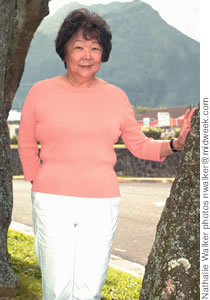Joyce Patrick

By .(JavaScript must be enabled to view this email address) | Share
 Del.icio.us
Del.icio.us
|
Joyce Patrick’s agenda is still packed despite a retirement from the airline industry six years ago. For five hours every Tuesday (at the barest minimum), Patrick volunteers at St. Francis Hospice, Hawaii’s largest and only nationally accredited hospice program for the terminally ill.
She began volunteering in 1993, but her association with St. Francis goes back almost 48 years. Patrick can still remember her days in the St. Francis Hospital School of Nursing program; with a smile she recalls faces and names of her classmates so quickly you’d swear she had just attended class yesterday.
It is this penchant for connecting with others, St. Francis PR manager Cheryl Tamura notes, that makes Patrick the best sort of aide.
“For more than 14 years, she has volunteered every Tuesday caring for patients,” Tamura says. “Over the years, she has given more than 4,000 volunteer hours! She also visits patients in their homes, providing respite to family caregivers.” Tamura adds that Patrick has been putting in time each week at Castle Medical Hospital for 28 years as well.
Unlike other caregiving facilities, Hawaii’s two St. Francis hospices in Liliha and Ewa serve as homes for patients whose doctors expect them to have less than six months to live. Volunteer aides such as Patrick selflessly provide 24-hour care to make life as comfortable as possible for both the patients and their families.
Patrick admits that while she enjoys what she does, it definitely takes a different breed of person to handle the toll of hospice care. Her duties include helping nurse aides with bathing and feeding, getting supplies, helping administer treatments and picking up medications. For patients who either don’t want to live in the hospice or are on a waiting list (the Liliha branch can only accommodate 12 patients at a time, Ewa 24), volunteers also go to homes. While the volunteer program is open to anyone, Patrick says many realize they are not emotionally strong enough for these demands.
“You never know how long you’ll be with a patient,” she sighs. But, she confides, she has made some lasting friendships with family members. And she likes to think that just being there for people is a refreshing relief from the inevitable.
“The greatest reward for me is just sitting and being with the patients,” gushes Patrick. “And the family members feel so relieved to have someone else there to help and to have someone they can trust. That is definitely the best part: to be part of a great service that provides comfort and care, to learn and just give of my time when it is needed.”
E-mail this story | Print this page | Comments (0) | Archive | RSS Comments (0) |
Most Recent Comment(s):













